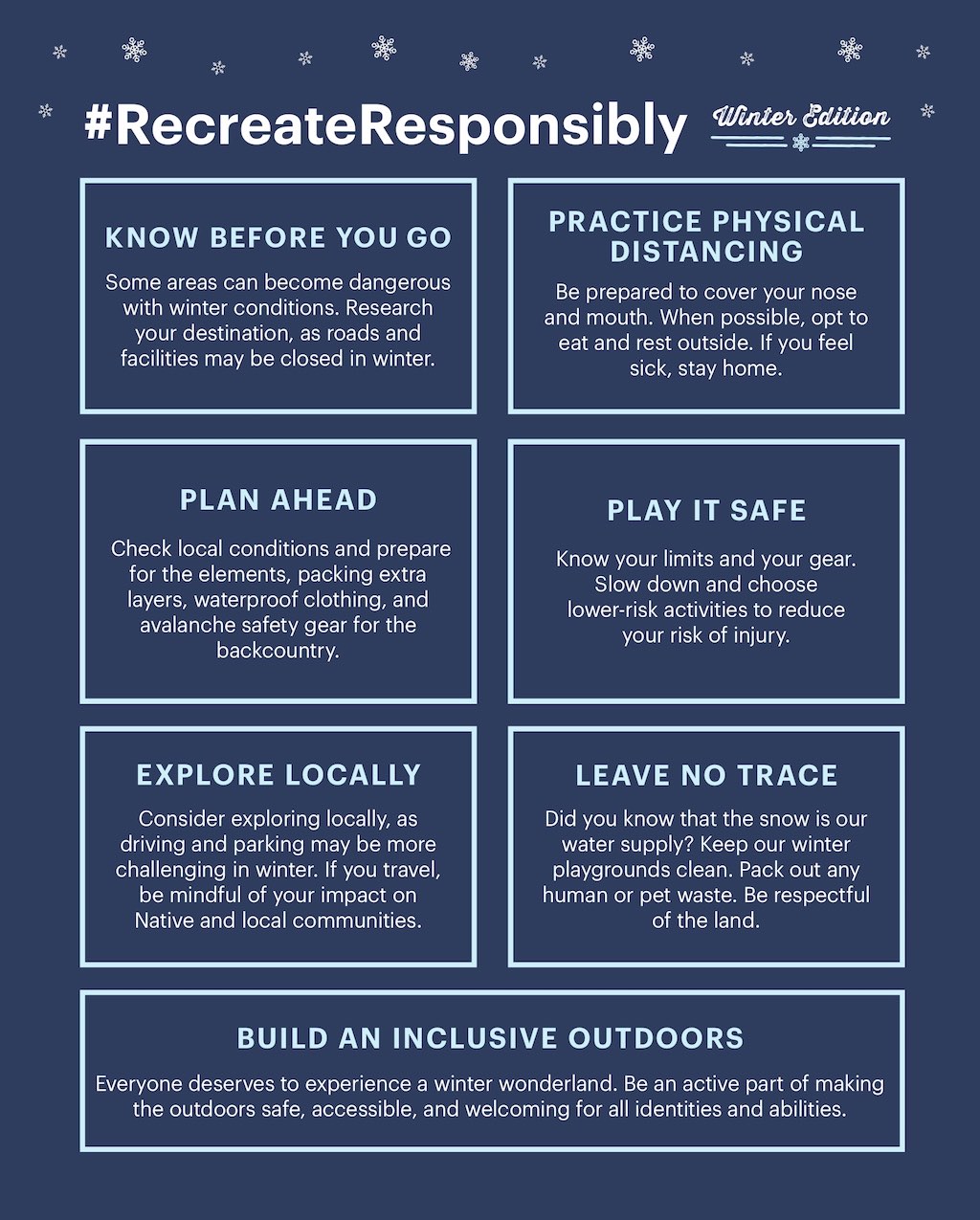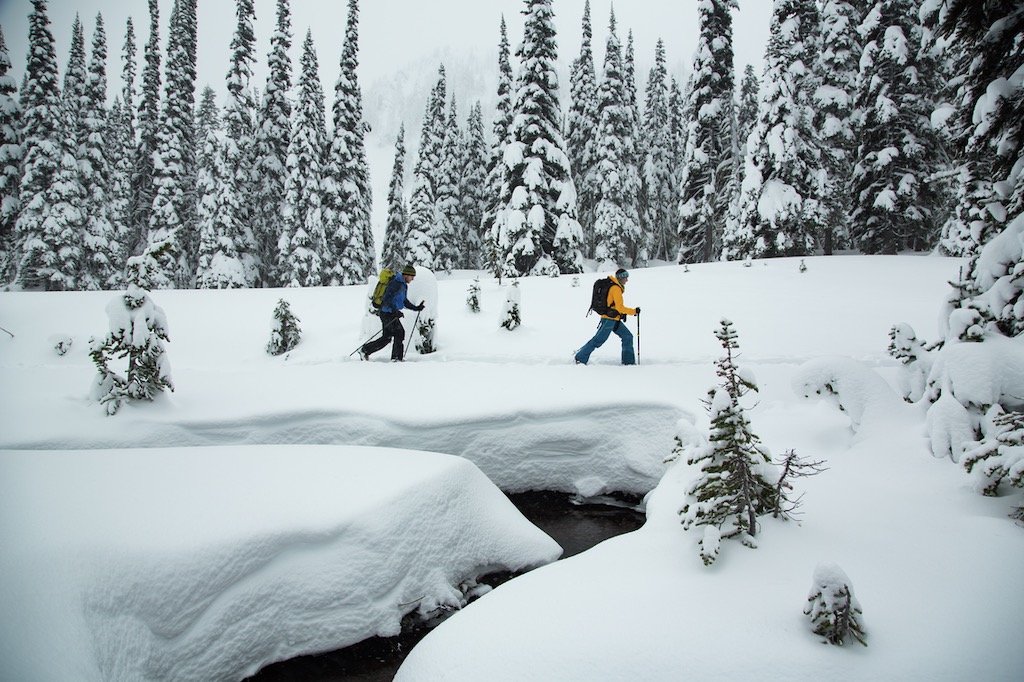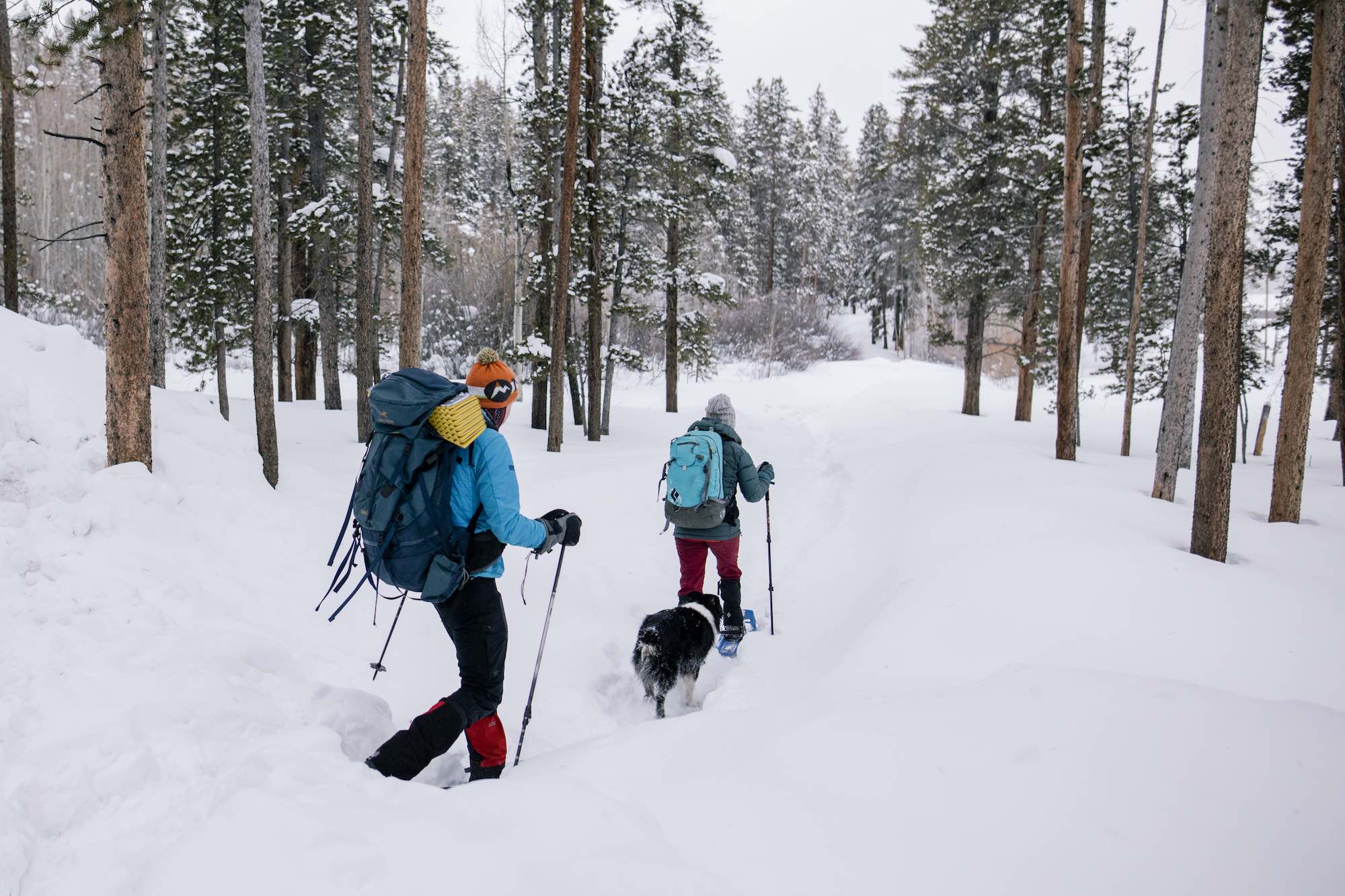Editor’s note: This article was first published on May 29, 2020. It was updated on Dec. 30, 2020 with the latest winter guidelines for responsible recreation.
With winter in full swing, many continue to venture outside to ski, snowshoe, hike or play in the snow—and find solace in nature during the current pandemic.
But spending time outdoors during a public health crisis isn’t so simple. Questions abound: Even if a trail is open, should I go? What should I bring with me? What measures should I take to protect myself and my community? Public health and other experts say it’s generally OK to get outside if you follow rules, take precautions and recreate responsibly.
REI and a coalition of agencies, nonprofits and recreation businesses have released simple Recreate Responsibly guidelines to highlight the emerging best practices and minimize confusion. Last month, the coalition updated the guidelines with considerations for winter outdoor activity. Overall, the guidelines are meant as a starting point for all outdoor activities to help people stay healthy and keep access open.

In addition to those guidelines, recreationists may have to weigh other considerations depending on their activity. For specific guidance related to winter activities, hiking, climbing, mountain biking, camping and paddling, we interviewed leading outdoor activity groups, along with public health experts.
All our interviewees stressed the need to follow CDC guidelines to help protect yourself and others from the coronavirus. They also reiterated Recreate Responsibly guidelines, like practicing physical distancing while outside, and because rules vary across states and counties, respecting local and state restrictions.
“People can and should (for their physical and mental health) get outdoors if they can do it in a way that avoids crowds,” Linsey Marr, a professor at Virginia Tech who studies the airborne transmission of infectious diseases, said in an email in May.
_____________________________________________________________________________
Winter Activities

Guidance from REI partners
Cold temperatures, limited sunlight, avalanche danger and snowy conditions add to the risk of recreating during the winter season.Tania Lown-Hecht, communications director of Outdoor Alliance, said it’s important to adequately prepare for conditions. Bring extra layers of clothing, enough food and the right gear, which can include items like headlamps and avalanche safety equipment. (Learn more cold-weather hiking and dressing tips). Also, access points may be more limited in winter so have a backup plan in the event a trail is crowded, a parking area is full, or a facility is closed.
People should also consider that, due to COVID, hospitals may have limited resources. Lown-Hecht stressed the importance of mitigating risk of injury by taking the right gear, learning the proper skills and knowing one’s limits.
“Right now, there’s a big surge in ICU capacity,” she said. “There’s never a good time to break a bone, but now is really not a good time to break a bone.”
Lown-Hecht added that it’s wonderful to see more people recreating outdoors but she stressed the importance of doing so safely.
Considerations while recreating during winter
Recreationists—from backcountry skiers to snowshoers and hikers—can expect a different experience in the mountains and backcountry this year due to COVID-19.
Resort skiers can expect longer lift lines, due to limits on how many people can ride in a chairlift together at a time, said David Page, advocacy director of Winter Wildlands Alliance. Rules may vary, so check with your resort.
Be prepared for some facilities, such as bathrooms, to be limited or closed due to staffing shortages, Page said.
All skiers should follow guidance from the CDC regarding the use of face coverings. And Page said new skiers and snowboarders should take lessons and avalanche training to ensure they have the proper skills to keep themselves and others safe. Many states saw an increase in search-and-rescue calls in 2020 as more people sought solace in the outdoors amid the pandemic. One search and rescue team in Colorado, for instance, saw a nearly 300 percent increase in call volume between 2019 and 2020. King County Search and Rescue in Washington state also broke records with its search and rescue calls.
Consider the burden on hospitals, some of which are at or near capacity with COVID-19 patients, Page said.
“We’re asking everyone to dial it back a bit. Ski smart. Maybe don’t take the risks you would if you knew you could be helicoptered out,” he added. “You don’t want to be that statistic.”
Ice climbers can follow guidance from the American Alpine Club, which suggests climbing close to home, avoiding vulnerable gateway communities and climbing with people from your own home or with just one partner.
Snowshoers and hikers can follow state and CDC guidance as well as the Recreate Responsibly guidelines, which suggest knowing your limits, checking local conditions, wearing a face covering and practicing physical distancing, among other things.
Hiking

Guidance from REI partners
Kate Van Waes, executive director of the American Hiking Society, says her group’s guidelines have stayed relatively consistent though they’ve been updated as areas reopen.
“Stay as close to home as you can. That still applies. It’s still generally not a good idea to travel too far because you can still potentially be spreading the virus from one community to another,” she says. “The farther you travel, the more stops you’re making, the more touch points you’re having.”
Even if a park is open, consider not going if it’s crowded, she says. “Just because it’s open, doesn’t mean, OK, now it’s a free-for-all,” she adds.
Van Waes acknowledges there’s not a one-size-fits-all approach for hikers. She encourages people to “use your best judgment based on where you live and the situation that you’re in.”
The situation will be different, for example, for someone who lives in a rural area where they may not come in contact with a lot of people than for someone in a more urban area.
Considerations while hiking
The Washington Trails Association notes that physical distancing may be hard to do on many popular trails. “If you can’t maintain 6 feet or more from other hikers, pick another place to hike,” the group says on its website. If a parking lot is more than half full, consider going somewhere else.
While hiking, give people space on the trail and pass with as much space between each group as possible.
“If you must be in an area where you’re passing people every few minutes, wear a mask,” writes Marr, the Virginia Tech professor. “If you are passing on the trail, one or both parties should step off the trail to allow for plenty of space; I have been using 10 feet as a guideline.”
Marr adds that quickly passing someone on the trail with proper distancing should be a very low-risk situation.
What about thru-hiking?
In March, the Appalachian Trail Conservancy urged hikers to stay off the popular 2,193-mile trail that runs from Georgia to Maine. And many hikers reconsidered their plans. The ATC notes that it is frequently updating its guidance and listings of trail-related closures and travel restrictions.
Looking ahead to 2021, the group said that the rising number of COVID-19 cases continues to make long-distance hiking a potential contributor to the spread of coronavirus along the trail and in trailside communities. “The best way to ensure you and others remain safe is to postpone your hikes,” the group said in a Nov. 30 post. “However, if you are planning a hike of any length in 2021, please reduce the spread of COVID-19 by preparing appropriately for your hikes,” it added.
Meanwhile, the Pacific Crest Trail Association also updated its guidance for visiting the PCT. The group previously urged hikers to stay away. It now “supports single-day hikes and horseback rides and longer, self-sustained trips that don’t require resupply near your home.” The group asks hikers to avoid travel from far away to the PCT. It also encourages people to follow you follow federal, state, county and city health emergency guidelines and recommendations for physical distancing
Go deeper
Read guidance from the American Hiking Society, Appalachian Trail Conservancy, the Pacific Crest Trail Association and Washington Trails Association.
Climbing

Guidance from REI partners
“Deciding whether it’s appropriate to head back out to your local crag will be an important and localized decision,” says the American Alpine Club on its website.
Access Fund asks climbers to consider not doing it but provides safety tips for those who go.
“We’re telling people they should strongly consider not climbing,” Chris Winter, executive director of Access Fund said in May. “We know that rock climbing usually involves being in close proximity to a partner, sharing gear. And sometimes it’s tough to keep your distance from other people at the crag.”
At the same time, he acknowledges, people are still going to climb.
“In our mind, simply telling people not to climb wasn’t going to actually have an impact on public health and climbing behavior in the way we wanted,” he says, adding, “We’re trying to strike the right balance.”
Winters encourages climbers to “make decisions based on what risks are posed to the most vulnerable and health care workers.”
Considerations while climbing
Both ACA and Access Fund advise climbers to avoid traveling to rural gateway communities with limited health care facilities. Also, limit partners to your household or one other partner, follow local guidelines, wear a mask when near others and climb conservatively, they say.
Dr. Marilyn Roberts, a professor at the University of Washington School of Public Health, department of environmental and occupational health sciences, says she would be concerned if people climbed with others outside of their household or in crowded areas.
“It’s fine with family members as long as not too many are rock climbing in the same area,” she says.
The issue is whether climbers could maintain physical distancing, such as if they drive together, climb in popular spots or are on routes with different parties at the same time, she says.
Go deeper
Read guidance from Access Fund and the American Alpine Club.
Mountain Biking

Guidance from REI partners
“In many places the trails feel more crowded than ever, so responsible riding and sharing the trails is as important as ever,” says David Wiens, executive director of the International Mountain Bicycling Association.
“If the local government and land manager have determined nearby trails are open, by all means, get some exercise and enjoy the outdoors,” he says. Wiens also reiterated the importance of responsible recreation, like the shared guidelines above.
Considerations while mountain biking
The biggest challenge may be staying six feet apart while passing other riders on the trail, Wiens says.
“The safest way to pass with distance is to stay alert, slow down and communicate with each other from a distance about how to proceed,” Wiens says. One person should step six feet off-trail to let the other pass. Leave your bike on the side of the trail to minimize environmental impact, he says.
Other tips? Ride at off-peak times. Try another trail on another day if it’s too crowded or have a backup plan. Consider riding with a bell to alert other trail users of your presence from a distance.
Check with state and local governments about trail openings and closures as well as guidance for travel.
Go deeper
Read guidance from IMBA and Evergreen Mountain Bike Alliance.
Camping

The rules vary by state
Check local, state and federal regulations for the latest guidance on whether camping is allowed. Some established state and federal campgrounds remain closed, as campgrounds bring people close together and have shared facilities, like restrooms. Recreation.gov is a good place to start for checking the status of federal campgrounds.
States are taking a variety of approaches. In Colorado, state parks officials remind visitors to follow best practices such as the 7 Principles of Leave No Trace and limiting groups to 10. In Idaho, officials remind people to recreate responsibly including staying as close to home as possible.
Rebecca Katz, director of the Center for Global Health Science and Security at Georgetown University Medical Center, told NPR that camping in an isolated outdoor location with your family may be a lower risk activity. Your risks increase if you’re at a crowded campground with a shared restroom and communal picnic areas, she told NPR in May.
“I wouldn’t be treating it as camping as usual,” says Van Waes, of the American Hiking Society. “Pack it all out. Use your judgment about the touch points you might have with other people and shared facilities. Don’t treat it like we’re all back to ‘normal’.”
She adds that Leave No Trace is even more important now that local and national parks are short-staffed and in some places crowded.
Paddle Sports

Guidance from REI partners
American Whitewater urges paddlers to make the health of others their number one priority. The group asks paddlers to respect restrictions and closures, stay local, be good river stewards and maintain physical distancing outside.
Evan Stafford, the group’s communications director, acknowledges that there’s quite a bit of personal opinions and reactions to the current situation.
“We know some people are going to get out,” he says. “Our take on it is that you can do it safely and we will make a real strong effort to provide very generalized guidelines to make it a safer experience.”
Considerations while paddling
Whitewater paddlers tend to gather at popular access points. “The take-out after-party is a regular occurrence and a part of paddling culture,” Stafford says. “We’re asking please don’t do that, especially in large groups.”
Shuttling between put-in and take-out areas can also be hard to do while social distancing. He advises paddlers to avoid car shuttles with folks outside their home. Get creative with alternatives, like biking between points.
Go deeper
Read guidance from American Whitewater and American Canoe Association.
_____________________________________________________________________________
REI writers Phuong Le and Sarah Grothjan contributed to this report.
